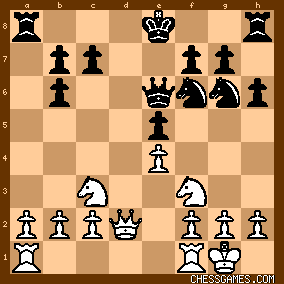| KEG: This game--which was to be the first in a series of a six game playoff involving the Pillsbury, Maroczy, and Schlechter who had tied for first place--was a triple tragedy: 1) The usually careful Maroczy committed a dreadful blunder on move 25b which led to his immediate resignation; 2) Maroczy, who was reportedly sick, withdrew from the playoff, accepted a third-place finish, and left Pillsbury and Schlechter to contest a four-game two-way playoff to determine first and second prizes. 3) This game was played on August 13, 1900. The 15th and final round had been played on August 11, 1900. IN between, on August 12, 1900, William Steinitz died. This was thus the first tournament game played in which there was no living former world champion (not counting the time when Steinitz was the first and only official world champion). This remained the case until April 1921 when Lasker resigned his title to Capablanca. Since then, there has always been at least on living world champion. (From 1946 to 1948 after the death of Alekhine, there as a living ex-champion--Euwe--but no current world champion until Botvinnik won the 1948 World Championship Tournament). Pillsbury and Maroczy had eight head-to-head games before the instant contest, Pillsbury winning three, Maroczy winning two, with three draws. 1. e4 e5
2. Nf3 Nc6
3. Bc4 Nc5
4. d3
Trying his hand at the Canal Variation of the Giuoco Piano. A safe but not especially pressing way to proceed as White. Seemingly a safety-first approach by Maroczy to an important contest against so brilliant a tactician as Pillsbury. 4... Nf6
5. Nf3 d6
6. Bg5 h6
Black must anticipate White's threatened 7. Nd5. The text and 6...Na5 are two ways to accomplish this. 7. Be3
This looks doubtful, since it allows Black to "mess up White's hair" with 7...BxB. White has two good ways to proceed here: 7. BxN and 7. Bh4. But contemporaries in the era in which this game was played disagreed. Schlechter played this against Lasker at Paris 1900 (in a game eventually won by Lasker), and the move was a favorite of Albin and the brilliant, mercurial Charousek. 
click for larger view7... Bb6
Though, as noted above, 7...BxB seems best, the text was the most frequent response to 7. Be3 back in the days this variation was played. 8. Qd2
Giving Black another chance. Maroczy should either have played 8. BxB or else played to avoid the exchange of his c4 Bishop with 8. a3 or 8. a4. 8... Be6
8...0-0 or 8...BxB were theoretically best, but Pillsbury probably preferred to try to keep more pieces on the board. 9. Bb3
He still should have exchanged Bishops (in this case, both pairs). 9. 0-0 or 9. a3 were also better than the text. 9... Qd7
Assuming Pillsbury did not want to initiate the exchange of minor pieces, he might have castled. 10. BxB(e6)
Maroczy finally decided to begin simplifying exchanges. 10... QxB
11. 0-0 Ne7
Struggling to create complications in an increasingly barren-looking position. 11...Ba5 or 11...0-0 look theoretically best. 12. BxB axB

click for larger view13. d4
Taking advantage of Pillsbury's eccentric 11th move, Maroczy assumed the initiative (for a short while, at least). 13... Ng6
14. dxe5
14. Rad1, 14. a3, and 14. h3 were all reasonable alternatives. 14... dxe5
Pillsbury at his best. He realized that the superficially better 14...Nxe5 (keeping his pawn structure intact) would have led to problems after 15. Nd4. After 14...dxe5, the position was:

click for larger view | 




